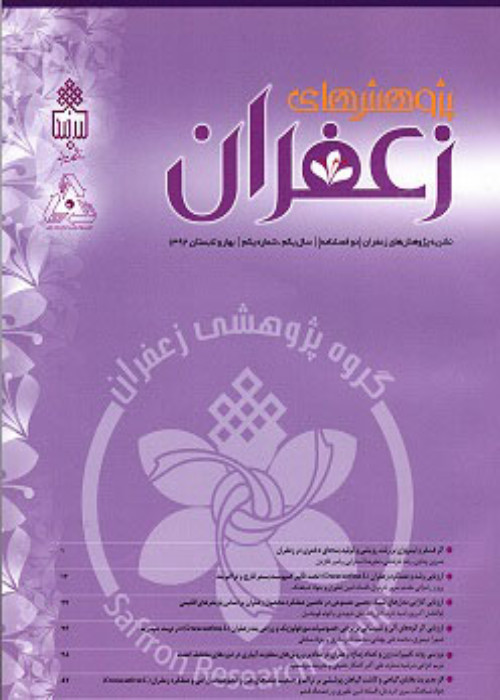Evaluation of Morphological and Biochemical Reactions of Saffron Plant to Salinity Stress
Author(s):
Article Type:
Research/Original Article (بدون رتبه معتبر)
Abstract:
Introduction
Saffron is a plant from the lily family, which has a special place among medicinal plants due to its great medicinal and spice value. All the factors that cause abnormalities in the process of plant growth are called stress. Salinity is one of the most important and common environmental stresses in the world, including Iran, which affects the quantitative and qualitative performance of many agricultural and horticultural crops. Considering the origin of life from the seas, salinity stress is probably the first type of environmental stress that living organisms have encountered during evolution. Generally, salinity has a noticeable effect on all the morphological, physiological, biochemical and anatomical characteristics of most plants and has a negative effect on the growth and development, survival and production of plants and affects the performance components depending on when the stress is applied to the plant. It affects the high concentration of salts in the rhizosphere along with the reduction of soil water potential and the creation of physiological drought stress as well as the creation of ionic toxicity and the imbalance of ions due to salinity stress harms the plant. The increase of various salts in the soil or irrigation water causes the plant to face salinity stress. When the plant is placed in a salty environment, the osmotic potential of the soil solution becomes negative and toxic ions such as sodium and chlorine accumulate. Salinity affects many plant growth and physiology characteristics and prevents their proper growth and performance. The biosynthesis of secondary metabolites in medicinal plants is not only genetically controlled, but also influenced by other environmental factors including salinity.Materials and Methods
In order to investigate the effect of salinity stress and ecotype on some biochemical characteristics of saffron plant, a factorial pot experiment was conducted based on a randomized complete block design with five levels of salinity (control, 50, 100, 150 and 250 mM) and three ecotypes (Ghainat, Torbat). Heydarieh and Sabzevar) were carried out with three replications in Pakdasht Varamin research greenhouse of Filistan village in 2017 and then transferred to the greenhouses of Gorgan University of Agricultural Sciences and Natural Resources in late fall of 2017. The measured biochemical traits were (chlorophyll a, b, total, carotenoid, total phenol, total sugar, proline and crocin). Data analysis was done with SPSS (Version 22), SAS and Excel 2016 software, and comparison of means was done using LSD method.Results and Discussion
Based on the results of data variance analysis, the effect of salinity stress on biochemical indices such as chlorophyll a, chlorophyll b, total chlorophyll, carotenoid, phenol, carbohydrate, anthocyanin, proline and crocin is significant at the probability level of 1%. The effect of ecotype on all measured parameters was significant at the probability level of 1%. Also, the interaction effect of ecotype and salinity stress on chlorophyll a, carotenoid, phenol, carbohydrate, anthocyanin, proline and crocin was significant at the level of one percent, but on chlorophyll b, total chlorophyll, at the level of five percent. The results showed that salinity stress had obvious and significant effects on morphological and biochemical traits of saffron. Among the salinity levels, the 50 mM salinity level is superior to the other salinity levels in most of the studied traits. This ecotype of Ghainat showed superiority in most of the studied traits compared to the two ecotypes of Torbet Heydarieh and Sabzevar.Conclusion
Sabzevar ecotype showed a higher content of crocin compared to the two ecotypes of Ghainat and Tarbiat Heydarieh at all levels of salinity stress. Based on the results of this research, the most tolerant ecotype to salinity stress is Ghainat ecotype, and the most sensitive ecotype to salinity stress is Sabzevar ecotype. Also, the best salinity level that had the least decrease in the studied traits was the salinity level of 50 mM.Language:
Persian
Published:
Journal of Saffron Research, Volume:11 Issue: 1, 2023
Pages:
124 to 138
magiran.com/p2617342
دانلود و مطالعه متن این مقاله با یکی از روشهای زیر امکان پذیر است:
اشتراک شخصی
با عضویت و پرداخت آنلاین حق اشتراک یکساله به مبلغ 1,390,000ريال میتوانید 70 عنوان مطلب دانلود کنید!
اشتراک سازمانی
به کتابخانه دانشگاه یا محل کار خود پیشنهاد کنید تا اشتراک سازمانی این پایگاه را برای دسترسی نامحدود همه کاربران به متن مطالب تهیه نمایند!
توجه!
- حق عضویت دریافتی صرف حمایت از نشریات عضو و نگهداری، تکمیل و توسعه مگیران میشود.
- پرداخت حق اشتراک و دانلود مقالات اجازه بازنشر آن در سایر رسانههای چاپی و دیجیتال را به کاربر نمیدهد.
In order to view content subscription is required
Personal subscription
Subscribe magiran.com for 70 € euros via PayPal and download 70 articles during a year.
Organization subscription
Please contact us to subscribe your university or library for unlimited access!



